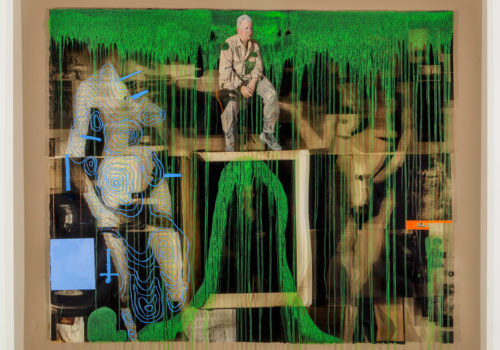Hand-coloured photographs date back to the mid 1800s when portraits were enhanced with spots of red on the cheeks and lips, or coloured in their entirety as a way of appeasing customers who were used to painted portraits. At that time hand-colouring was a commercial endeavour and purists of both painting and photography looked unfavourably at the practice, which was often carried out by women employed as colourists.
Eventually the introduction of colour photography put an end to the need to paint photographs, but in the post-modernist era hand-colouring made a come back, this time as an artistic pursuit. Photographic artists began to experiment with pencils, crayons and paints on photographs blurring the lines between high art and pop culture. Hand-colouring was viewed as somewhat anarchistic, its resurgence coinciding with the feminist and punk movements and the ‘anything goes’ mentality of the times.
In a new exhibition at the National Gallery of Australia – Colour My World – this period of experimentation in Australian photographic history is celebrated with an expansive collection from a diverse group of artists – Micky Allan, Ruth Maddison, Warren Breninger, Julie Rrap, Janina Green, Christine Barry, Fiona Hall, Miriam Stannage, Robyn Stacey, Nici Cumpston, Lyndell Brown/Charles Green and Jon Cattapan.
Micky Allan is considered a pioneer when it comes to hand-painting as she was one of the first to engage with the form in this country. Having trained as a painter, Allan extended the concept of hand-colouring with dyes by using watercolours, oil and acrylic paints as well as pencils.
She says the tactile nature of painting led to her experimentation. “I didn’t like the darkroom very much and I couldn’t wait until the photo was ready to paint. When you touch the photograph directly, like in painting or drawing, it creates this direct link to all those little brain tremors that come out the hand, whereas in the darkroom it felt different. Because I am naturally a painter I liked the combination and the unexpected outcomes with cross overs of media”.
“I wanted to combine the fluid nature of paint with those elements of the photograph that are so peculiar to photography, like that fabulous tonal range and the fact that there is this sense that this place is real, or this event happened, or this person exists,” she explains.
In particular, women readily embraced the intimate involvement with the artwork that hand-colouring necessitated. This is evidenced in the weighting of female artists in ‘Colour My World,’ a rarity for an exhibition that spans an era in Australian photography where men dominated.
Ruth Maddison, whose work is also on show, was drawn to hand-colouring and its interactive nature, and this form influenced her early career in the 1970s. In recent years she’s revisited the practice and says, “hand colouring allows me to work directly on the object as well as giving me time away from the screen – a much more enjoyable and calming way to work”.
One of Australia’s most acclaimed photographic artists Robyn Stacey embraced the form in the early 1980s creating a series of hand-coloured artworks entitled Queensland – Out West. She says, “hand-colouring seemed a good way to visually re-enforce the personal and intimate quality of the prints, as well as being sympathetic to the subject matter”.
Throughout the eighties Stacey continued to experiment with hand-colouring and various images are included in ‘Colour My World,’ which is the first exhibition curated by the National Gallery of Australia’s new Senior Curator of Photography, Dr. Shaune Lakin.
“This exhibition brings together some of the most beautiful photographs made by Australian photographers over the last four decades,’ says Lakin. ‘It captures and reflects our diverse community and provides a unique perspective on the place of photography in our lives, at a time when the act of taking photographs has become a daily occurrence for many of us.”
EXHIBITION
Colour My World
Until 30 August, 2015
National Gallery of Australia
Parkes Place, Parkes
Canberra ACT 260
Australia
http://www.nga.gov.au
















